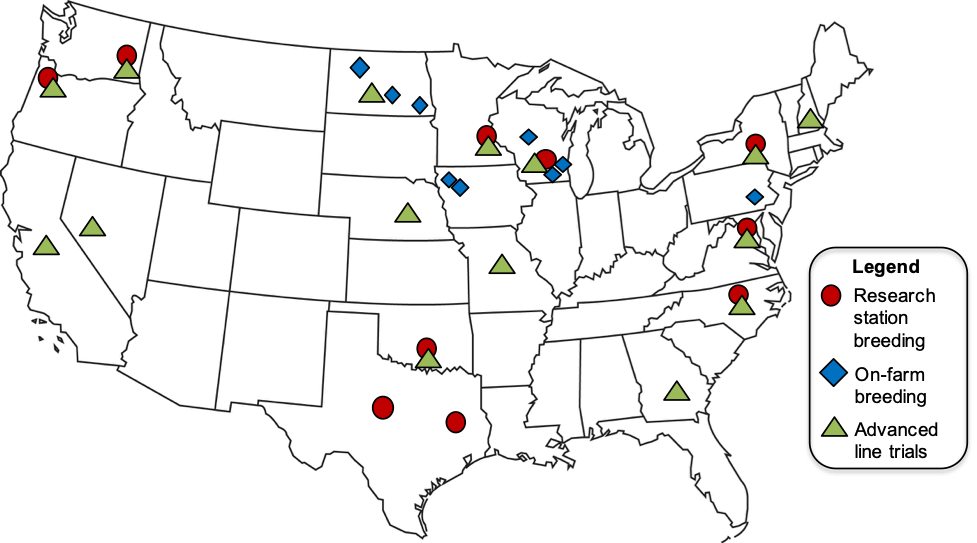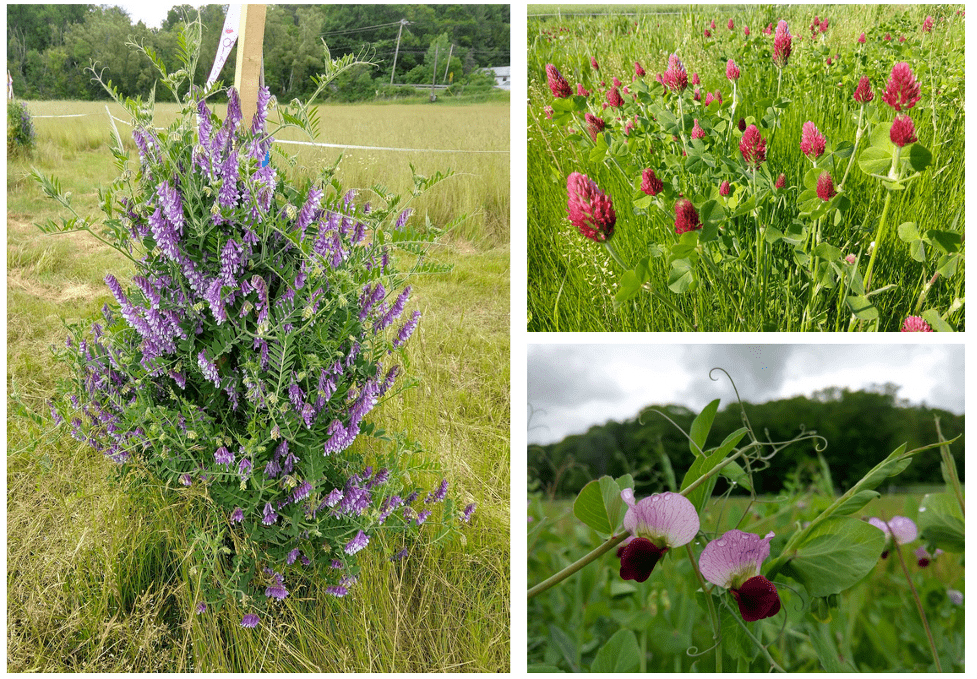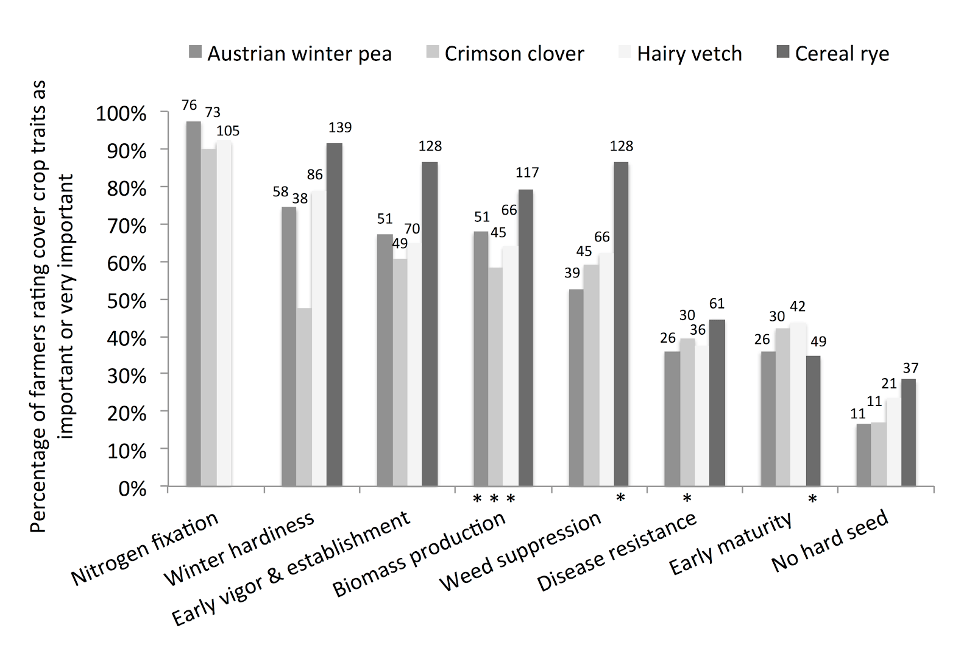Sandra Wayman1, Lisa Kissing Kucek2, Virginia Moore3, Lais Bastos Martins4, Matt Ryan1
1Soil and Crop Sciences Section, SIPS, Cornell University, 2USDA ARS Dairy Forage Research Center, 3currently: NC State University. Feb 2021: Plant Breeding and Genetics Section, Cornell University, 4Crop and Soil Sciences, NC State University.
Legume cover crops have room for improvement
Winter annual legume cover crops are essential management tools for organic farmers; they fix nitrogen, improve soil health, and suppress weeds. Winter annual cover crops are planted in the early fall, overwinter, then grow vigorously in the spring and complete their life cycle in the summer. However, many farmers struggle with these cover crops. Poor emergence, low vigor, and winter kill are basic challenges that could be addressed through plant breeding. Unlike cash crops, cover crops have received relatively little attention from plant breeders in the past. Thus, even modest investments in germplasm improvement could return large benefits. The Sustainable Cropping Systems Lab is taking advantage of this opportunity to improve legume cover crops for organic farmers by participating in the national Cover Crop Breeding Network (Fig. 1). Sites across the U.S. are developing cover crop lines best suited to each region. Our goal is to develop new varieties that boost the sustainability of organic farms, using classical plant breeding methods rather than genetic engineering. We are working with three species of winter annual legume cover crops: hairy vetch (Vicia villosa), crimson clover (Trifolium incarnatum), and winter pea (Pisum sativum) (Fig. 2).


The traits farmers want
To inform our breeding efforts, we conducted a national survey of organic and conventional farmers to learn which cover crop traits were important to them (Fig. 3, Wayman et al 2017). We received 417 responses to the survey, and 87% of the respondents reported they used cover crops. Organic farmers reported placing greater value on the ecosystem services from cover crops than did conventional farmers. The top four traits chosen by respondents as important for legume cover crops were nitrogen fixation, winter hardiness, early vigor and establishment, and biomass production (Fig. 3).

Genetic improvement
The steps in developing better cover crop varieties for farmers are 1) create better genotypes through breeding nurseries, and 2) select the best new varieties through advanced line trials. Researchers at different sites in the project are selecting for different legume traits based on their region. In the legume cover crop nurseries planted at Cornell University, we are selecting for winter-hardiness in addition to early-flowering.
We began the breeding program with seeds of hairy vetch, crimson clover, and winter pea from commercially available varieties, lines from worldwide breeding programs, landraces selected by farmers, and PI (plant introduction) lines from the U.S. National Plant Germplasm System Germplasm Resources Information Network (NPGS GRIN) seed bank.
For five seasons, we have planted breeding nurseries of the three legume cover crop species at our Cornell University site. We selected plants based on fall vigor, low winterkill, spring vigor, early maturity, and soft seed. We culled undesirable plants before flowering, and saved seeds from the best plants to replant in the following year. We selected between 2.8% and 4.6% of the hairy vetch individuals across the breeding seasons, and between < 0.01% and 2.8% of crimson clover individuals.
For winter pea, the first year of the breeding program evaluated the performance of accessions from the National Plant Germplasm System. The results informed what material to include in breeding nurseries. For the following three seasons, we planted and selected early generation breeding lines originating from the USDA-ARS Grain Legume Genetics Physiology Research Center in Pullman, WA. The best 0.5 to 1.4% of the winter pea plants were chosen as new breeding lines, based on winter survival and vigor. In 2019, the winter peas experienced severe winter conditions 900 feet above Cornell University’s campus, where almost all the winter peas died from winterkill.
Advanced line trials
In the 2018-2019 and 2019-2020 seasons, our breeding lines were tested against commercial varieties in multi-environment advanced line trials. Sites across the country (Fig. 1) grew replicated plots of breeding lines and commercial checks of each legume cover crop species. Each trial grew the legume cover crops alongside triticale to simulate grass-legume cover crop mixes typically grown by farmers. Breeding lines of each crop were compared with commercial check varieties to assess if our breeding program has produced something better than what is currently available to growers on the market. Lines were evaluated for emergence, winter survival, fall and spring vigor, flowering timing, disease, and biomass. The best lines of each species will be tested again in the 2020-2021 season, and performance of these lines will determine variety release and commercialization.
Nursery and advanced line trial performance
Testing variety performance is currently underway. An analysis of the advanced line trials will identify if any lines perform well across the U.S., or if certain lines excel in specific regions. Ideally, we would find a few breeding lines performing well across all sites. Such “broadly adapted” lines could be sold as varieties nationwide. If certain lines are excellent in specific regions, however, seed companies are interested in selling lines as “regionally adapted” varieties. In the meantime, data from the breeding nurseries indicated patterns in regional performance. The results suggest different trends among species, which are detailed below.
Hairy vetch
We found no hairy vetch line that performed best in both the fall and spring (Kissing Kucek et al. 2019). Instead a tradeoff between fall growth and spring growth was observed. As a result, the breeding program is screening and selecting for vigor at both times of the year, with the goal of finding ideal lines that have the best overall seasonal performance.
Over two seasons and a dozen U.S. sites (Fig. 1), we tested 16 hairy vetch breeding lines and six checks. Breeding lines developed by the Cover Crop Breeding Network beat the commercial check lines in both years. Winning lines, however, differed among sites. Colder northern environments had different winning breeding lines than warmer southern and western sites. Our Cornell University site proved to be an intermediate winter environment compared with the harsh upper Midwest and mild southeast and west. In cold winters like 2018-2019, Cornell University shared winning lines with MN, WI, and NE. In contrast, during warm winters like 2019-2020, NY was more similar to southern and western sites. These results suggest that the best performing lines in NY may vary depending on weather conditions, with warmer years in NY mimicking southern and Mid-Atlantic sites, and colder winters grouping NY with the northern Midwest. To select for resilient lines that can handle variable winter conditions, Cornell University breeding nurseries include material from warm and cold regions of the U.S.
The 2018 hairy vetch line from Cornell University was the second highest seed yielding in our OR trials, demonstrating 25% more seed yield than checks (Hayes and Azevedo, 2019). High seed yield is a very desirable trait for seed growers and seed companies.
Crimson clover
Two commercially available varieties of crimson clover, ‘Dixie’ and ‘Linkarus’ were included as checks in our trials. ‘Dixie’ is a variety developed in GA that exhibits high forage biomass production, ability to reseed, and high amounts of hard seed (Hollowell 1953). ‘Linkarus’ is a highly productive winter hardy crimson clover which was developed in Germany. In general, we have seen ‘Dixie’ perform well in the southern locations, while ‘Linkarus’ performs better at northern locations. In the harsh NY winter of 2018-2019, our breeding lines beat both ‘Dixie’ and ‘Linkarus’.
In two seasons, we also evaluated crimson clover breeding lines for biomass production at Cornell University. Biomass production is important for all farmers, who often use crimson clover as a green manure. The crimson clover lines with the highest biomass production were included in the next season’s nursery. At our Cornell University site in 2018, ‘Linkarus’ had the highest biomass production, with 1.5 to 2.9 times more biomass production than ‘Dixie.’ Additionally, to compare top-performing lines from nursery selections at a dozen sites across the country, we tested 13 crimson clover breeding lines and 2 checks over two seasons. In the first season, a soft-seeded MD breeding line produced the most biomass, followed by ‘Linkarus’ and a Cornell University breeding line. In the second season, ‘Dixie’ produced the most biomass, followed by a MD breeding line.
Breeding lines have also been tested for seed yield in OR, where most crimson clover seed is produced. The two checks beat all breeding lines for seed yield (Hayes and Azevedo 2019). As a result, we have increased our focus on selection for seed yield in the crimson clover breeding program.
Winter pea
In NY, winter peas have often been challenging for farmers due to poor winter survival. In the 2017-2018 season, 0.5% of plants were selected based on winter survival and vigor. Their seed is currently being increased so they can be included in future advanced line trials. In the 2019-2020 season, our Cornell University site experienced optimal weather to discriminate cold tolerance. Data from 39 new and different genotypes helped us choose the entries with the best potential to be increased for the advanced line trial.
Over two seasons, we tested 21 winter pea lines and five checks in our advanced line trial. In the 2018-2019 season, the winter pea advanced line trials did not survive at Cornell University and in MN due to harsh winter conditions. Southern locations (CA, GA, NC, OR) of the advanced line trials had overall higher biomass production than did the northern locations (MD, MO, NE, WI) in 2018-2019. Across all sites, our breeding lines performed better than the checks. Indeed, one of our breeding lines was in the top five performers across five different locations, showing good potential for release as a variety. Many of our breeding lines performed better than the two commercially available cultivars in the trial.
An additional observation for winter pea is that lines with the highest vigor in fall may have poor biomass production in the spring. This is not uncommon in peas; if the plants grow too much in the fall their exposed above-ground biomass is susceptible to frost damage and winter kill.
Next steps
As part of this project, we will release varieties of legume cover crops adapted to specific regions. Our next steps include selecting for high-vigor and improved material in our nurseries, continuing advanced line trials with this new material, planting seed increases, and inviting farmers and seed company representatives to the breeding sites to evaluate the lines. We planted a third year of advanced line trials in 2020, after which we will determine if any lines are consistently high performers and good candidates for variety release.
Cover Crop Breeding Network team member coming to Cornell
In February 2021, a Postdoctoral Scholar with the team, Virginia Moore, will join Cornell as an Assistant Professor with SIPS in the Plant Breeding and Genetics Section. Virginia’s program will focus on breeding for sustainable cropping systems. Virginia has been involved in the national Cover Crop Breeding Network as a project manager since 2019. She is currently based at USDA-ARS in Beltsville, MD, and completed her graduate work at the University of Wisconsin, with a MS in Agroecology and Agricultural & Applied Economics and a PhD in Plant Breeding & Plant Genetics. She sees plant breeding as a powerful tool to increase sustainability of cropping systems, with goals like a) reducing pesticide inputs through breeding for pest resistance, b) increasing cover crop adoption by developing regionally adapted cultivars, c) selecting crops for organic systems, and d) diversifying cropping systems through rotations and intercropping. She is excited to continue working in cover crop breeding and to take on new crops including alfalfa and other forages, hemp, and switchgrass.
Acknowledgements:
Thanks to Gerald Smith for sharing data and resources. Thanks to Chris Pelzer, Katherine Muller, Dylan Rodgers, James Cagle, Nina Sannes, and Matt Spoth for help planting the nurseries.
References
Hayes, R and M. Azevedo. 2019. Seed yield of hairy vetch and crimson clover breeding lines. Raw data available upon request.
Hollowell, E. A. 1953. Registration of varieties and strains of crimson clover (Dixie crimson, Reg. No. 1). Agron. J. 45:318-320
Kissing Kucek, L.; H. Riday; et al. 2019. Environmental influences on the relationship between fall and spring vigor in hairy vetch (Vicia villosa Roth). Crop Science. 59:1-9
NordGen. Accession Number: NGB8658. Accessible at: https://sesto.nordgen.org/sesto/index.php?scp=ngb&thm=sesto&lst=&accnumtxt=NGB8658. Accessed April 26 2019.
Wayman, Sandra & Kissing Kucek, Lisa & B. Mirsky, Steven & Ackroyd, Victoria & Cordeau, Stéphane & Ryan, Matthew. (2017). Organic and conventional farmers differ in their perspectives on cover crop use and breeding. Renewable Agriculture and Food Systems. 32. 376-385. 10.1017/S1742170516000338.
